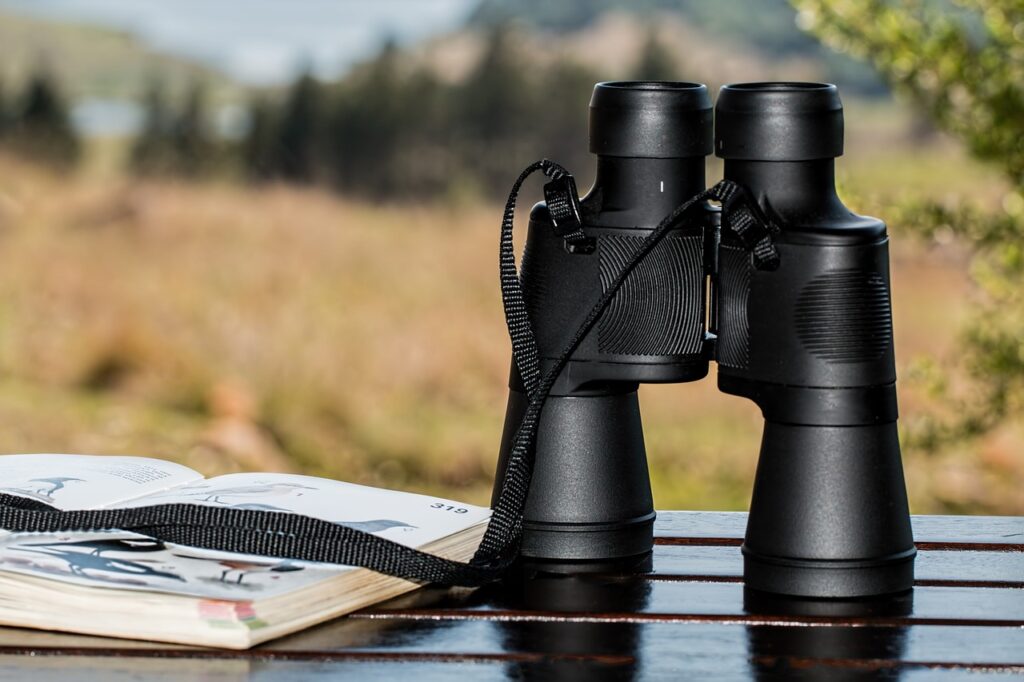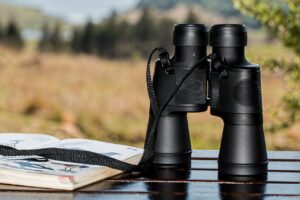Last Updated on April 3, 2024 by ETC Team

If you’re new to the world of binoculars, the specifications and terminologies used to describe each type may be confusing. To assist you in solving this difficulty, we’ve listed some basic aspects to consider when selecting the best hiking binoculars to fit your needs. This guide will help you choose binoculars for hiking that you will enjoy using and will take your sightseeing while hiking to the next level.
Magnification
The magnification for binoculars is a number that describes how much the image you see through the binoculars is enlarged. This number can be measured in two ways; by linear or angular magnification. The linear magnification of a pair of binoculars refers to how many times larger an object appears than it would without them. In contrast, angular magnification refers to how large an object appears at a distance of one meter.
Researchers and the military, in particular, have the most powerful binoculars, which can magnify up to 20 times. However, for hiking, 6x to 10x is more than sufficient. Consider these differences when you choose binoculars for hiking.
Moreover, The size of the lens is a crucial factor in determining the quality of a binocular. The larger the lens, the more light it can gather and provide better image quality.
Weight and Size
Weight and size are two of the most important factors to consider when you choose binoculars for hiking. The weight should be as light as possible, preferably under a pound, and it should be compact enough to fit in a backpack.
The size is also essential because you want the binoculars to fit your face well, especially wearing glasses. You also want it to have a good field of view so that you can see as much as possible at once.
Field of View
The field of view is vital when you choose binoculars for hiking. Field of view is a measure of how wide an area can be seen at any one time through binoculars. The magnification is usually inversely related to it. The field of view is generally expressed as the number of feet seen at 1000 yards.
You’ll need a narrower field of view with a crisper focus if you need to zoom in a lot. Finding moving targets in a confined area will however, be more challenging. On the other hand, the larger field of view, is ideal for observing marks while moving, but it has a lower focus.
Durability
Binoculars are typically composed of synthetic rubber, which protects the binocular body from damage caused by shocks, blows, drops, and other factors. A good covering on your binoculars will indicate how durable they are.
The finer the exterior coating is, the more you’ll spend on your binoculars. If your plan is to use your binoculars for trekking and camping on a regular basis, you’ll need a pair that will both withstand the outdoors while also being easily portable. Whatever the case may be, your binoculars must be able to withstand the environment with regular use. Keep this in mind when you choose binoculars for hiking.
Type of Prism
Prisms in compact binoculars are divided into two categories; Porro prism and roof prism. Porro prism binoculars tend to be cheaper and more compact than roof prism binoculars. The main difference between the two is that Porro prisms work by reflecting the light from one side of the lens to the other side, while roof prisms work by bending light through a 90-degree angle.
Roof prism binoculars have a perfect alignment of the eyes and lens. This allows for binoculars with a sleek and minimalist appearance.
On the other hand, the lens and eyepiece of the Porro prism compact binoculars are not in a single direction. The glass elements are separated, resulting in improved optical efficiency. Porro prism binoculars are ideal for hiking and birding, and tend to have a slightly thicker shape. However, they have a broader angle of vision.
Eye Relief
Eye relief is the fixed distance between your eyes and the lens of the binoculars. The smaller the eye relief, the greater the magnification. Over time you can injure your eyes from straining too much when your view is blurry or obstructed. If you wear glasses, this is an excellent feature to keep an eye on as well. Eyeglass wearers can use binoculars without removing their glasses. And since the glasses already place a distance between the eye and a lens, it affects the eye relief measurement. This is an important factor when you choose binoculars for hiking.
Waterproof
Waterproof binoculars are designed to be waterproof, fog proof, and snowproof. They are ideal for outdoor enthusiasts who want to see clearly in all weather conditions.
Moreover, waterproof binoculars will help you enjoy the outdoors without worrying about getting your gear wet. They are also helpful for those who like to go fishing or boating.
Be aware, too, that manufacturers sometimes describe any level of water resistance as “waterproof”, even though there is a distinction. Be sure to check whether the binoculars are rated as weather-resistance vs. waterproof. Always check the binoculars for an IP code or Ingress protection code. This indicates how well a device, in this case binoculars, is protected against water and dust. This is defined by the International Electrotechnical Commission (IEC).
Price
Binoculars are available in a variety of types and versions that will come with different prices. Because the high complexity required in developing high-quality glasses is quite expensive, the price will be heavily influenced by the quality of their optics.
Ideally, the binoculars you buy will be with you for the foreseeable future. You want binoculars that will provide you with many years of hiking, trekking, fishing, hunting, birdwatching, and the list goes on. A price that seems costly at first will end up being less expensive when you multiply it by the number of decades. Most hikers maintain the same binoculars for decades, so selecting the correct pair from the start is critical.
Frequently Asked Questions
Are Binoculars Worth It For Hiking?
Undoubtedly, buying a worthy Hiking Binocular is a significant investment. Indeed, Binoculars are a must-have for hikers. They are used to enhance the vision and see faraway objects better.
Hikers need binoculars to help them see things that are hard to spot with naked eyes. Moreover, you can use them for many purposes like bird watching, hunting, and even military operations.
Why Do Hikers Use Binoculars?
Binoculars are a type of optical instrument used for viewing distant objects. They can magnify the object, making it appear closer to the viewer. Hikers use binoculars to see things at a distance, such as wildlife and other hikers.
How Do You Carry Binoculars On A Hike?
You can carry your binoculars on a hike by wearing them around your neck or holding them in one hand. You can also store them in your backpack when not in use.
I See 10×42 And 8×42. What Does It Mean?
10×42 binoculars are designed to give 10 times the standard pair of binocular magnification. At the same time, 8×42 binoculars are designed to provide 8 times the magnification of a standard pair of binoculars.



